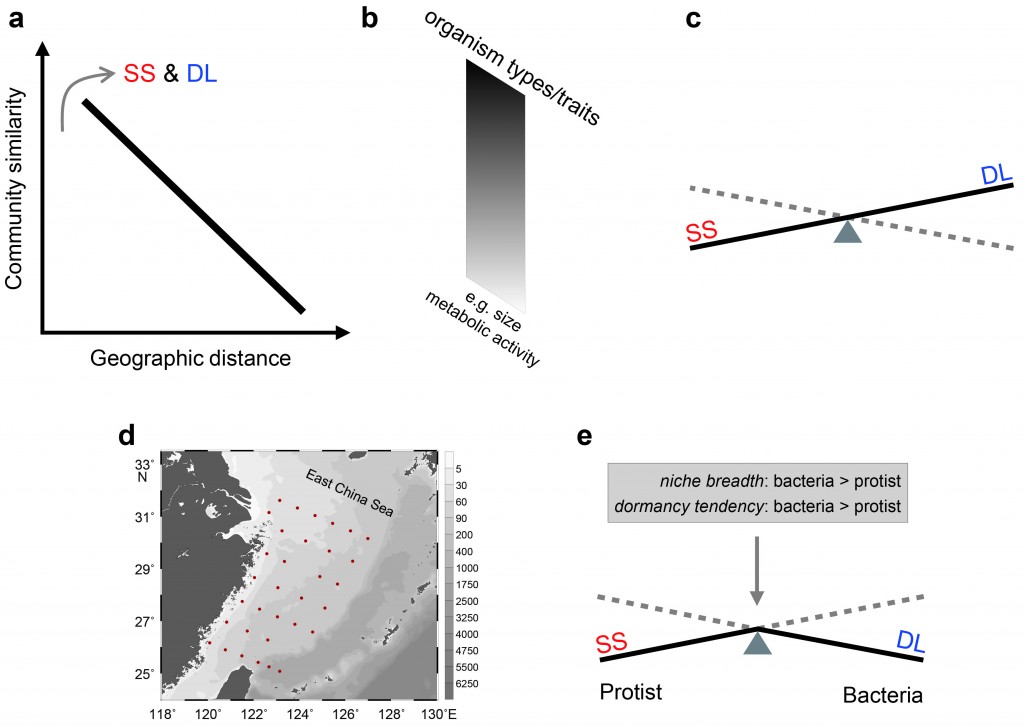Marine bacterial and protist communities are differentially influenced by species sorting and dispersal limitation
Wenxue Wu and Chih-hao Hsieh
Institute of Oceanography, National Taiwan University
Bacterial and protist communities are the two key components in marine microbial food webs. Even though they are both microbes, these two groups can be geographically structured in distinct manners due to their differences in organismal traits. For example, bacteria and protists do exhibit fine differences in body size, metabolic activity and dispersal potential, in spite of their comparable attributes (e.g., small body size and short generation time). In view of the metacommunity concept, these differences can influence the relative importance of species sorting and dispersal limitation (Figure 1a–c). However, the extent to which these two processes drive geographical patterns for organisms at different trophic levels has not been adequately explored in marine ecosystems.
A research team at the Institute of Oceanography in National Taiwan University, led by Dr. Wenxue Wu and Prof. Chih-hao Hsieh, showed new findings for this fundamental question. They collected field samples over the East China Sea at the basin scale using the R/V Ocean Researcher I in August 2014 (Figure 1d). They carried out investigations in three depth layers (surface, deep chlorophyll maximum, and bottom) considering an important fact that oceanographic dynamics vary across depth. Bacterial and protist communities were simultaneously obtained by Next Generation Sequencing technology. A set of environmental variables were measured, including temperature, salinity, chlorophyll concentration, nutrients, and etc. Then, the relative importance of species sorting and dispersal limitation was quantified based on these large-scale, three-dimensional data.
The researchers found that protist communities were governed more strongly by species sorting relative to dispersal limitation than were bacterial communities (Figure 1e); this pattern was consistent across the three depth layers. This contrasting pattern of community assembly may be attributed to differences in habitat niche breadth (bacteria > protists) and dormancy tendency (bacteria > protists) between these two microbial groups. Their findings indicate that smaller organisms (bacteria) are less environment-filtered than larger organisms (protists), as smaller organisms are more likely to be plastic in metabolic abilities and have greater environmental tolerance.
This study demonstrates the advantage of examining community assemblies of organisms of comparable attributes to yield a better resolved understanding of metacommunity dynamics. This study also shows the importance of considering the three-dimensional nature of marine systems when conducting metacommunity studies. This work has been published in The ISME Journal (2017, Advance online publication).
Figure 1. A conceptual scheme for exploring the relative importance of species sorting (SS) and dispersal limitation (DL) in shaping marine microbial communities. Marine microbial communities typically show a distance-decay of similarity that is basically determined by species sorting (i.e. the selection by local environmental conditions) and dispersal limitation (a). The difference in organismal types/traits such as size and metabolic activity (b) are expected to influence the relative importance of species sorting and dispersal limitation (c). For example, in the East China Sea at the basin scale (d), bacteria and protist communities are differently influenced by species sorting and dispersal limitation, which may result from their differences in their niche breadth and dormancy tendency (e).
Reference:
Wu W, Lu H-P, Sastri A, Yeh Y-C, Gong G-C, Chou W-C and Hsieh C-H (2017) Contrasting the relative importance of species sorting and dispersal limitation in shaping marine bacterial versus protist communities. ISME J doi: 10.1038/ismej.2017.183. Available at: http://www.nature.com.











